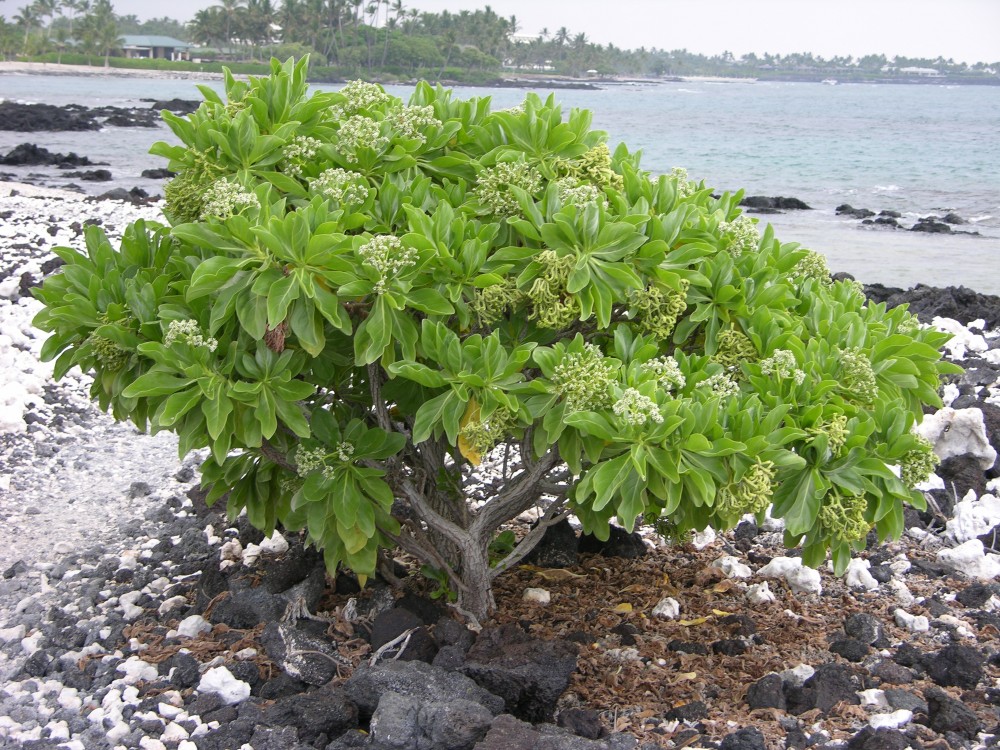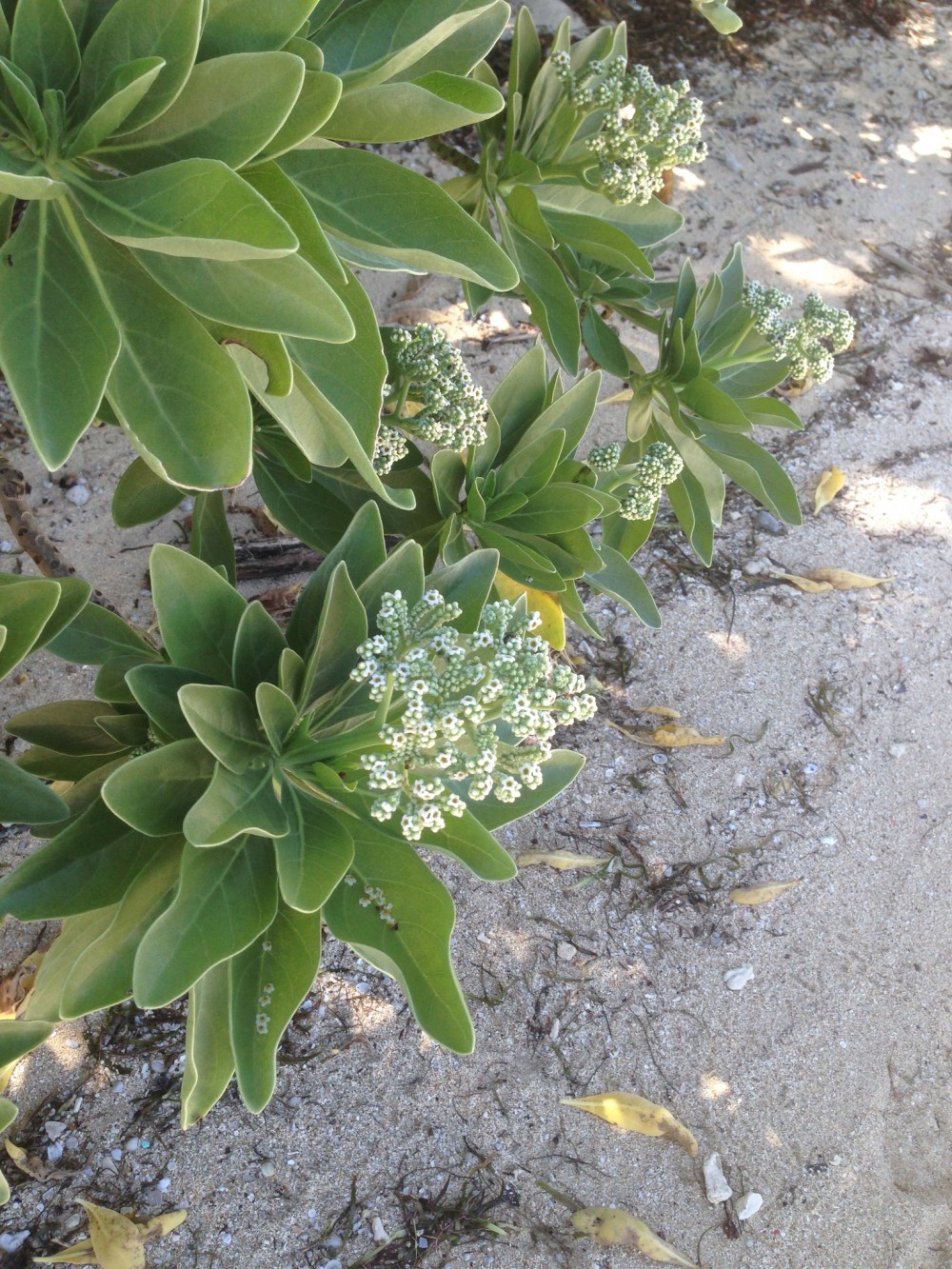Tree Heliotrope connectivity
Introduction to Tree Heliotrope connectivity and why it is important
Tree Heliotrope (Heliotropium foertherianum) is a shrub or small tree, typical of littoral zones, 1-5 m tall, with a spread of about 5 m. It is a strand plant of coastal environments, and is often found near the water’s edge, even where waves occasionally wash over its root system or batter its lower trunk or roots. It is capable of growing in saline conditions and in nutrient-poor sands and rocky soils, and often forms the seaward fringe of vegetation.
Originally published as Tournefortia argentea, it was transferred to Argusia argentea, and remained under that name until it was subsequently restored to Tournefortia before being transferred into Heliotropium under the new accepted name Heliotropium foertherianum in 2003!
Common names of this flowering plant include velvetleaf tree heliotrope, soldierbush, veloutier and octopus bush.
Conspicuous features of tree heliotrope is its light grey and deeply corrugated bark, and its light green leaves which have a silvery-grey sheen, and a silky white pubescence on the underside. The slightly fleshy leaves are simple, alternate and whorled (spiralled) at the branch tips. The inflorescence is pubescent and conspicuous, composed of numerous small, white, sessile flowers, arranged in multi-branched, terminal flower clusters with a central stem bearing a single terminal flower that develops first, the other flowers in the cluster developing as terminal buds of lateral stems. In some areas, it generally flowers and sets fruit nearly continuously throughout the year. The small fruit is greenish-white to brown, smooth and 5 mm in diameter.
Distribution: Native throughout the Indo-Pacific Region including southern China, Madagascar, northern Australia, and most of the atolls and high islands of Micronesia and Polynesia, except Hawaii where it has now been introduced.
Introduction to the attribute/value and why it is important
Where the tree is native, it is very important for traditional cultures. The leaves are used for vegetables or spice; the wood is used for an array of handicrafts, tools, canoe building and utility items. Throughout the Pacific, the leaves are highly valued for their medicinal properties (e.g. to treat rashes, infected cuts and diarrhoea) and it also plays a role in various rituals.
In many Pacific islands it is used as a traditional medicine to treat ciguatera fish poisoning, which is caused by powerful ciguatoxins produced by microscopic algae. Scientists are researching the plant chemistry and believe that senescent leaves contain rosmarinic acid and derivatives, which remove the ciguatoxins from their sites of action, as well as being an anti-inflammatory. Rosmarinic acid is known for its antiviral, antibacterial, antioxidant, and anti-inflammatory properties.
Due to its availability, particularly on beaches, H. foertherianum is used as firewood, and has become rare in some areas as a result. It is also valued for the shade it produces in harsh coastal environments.
As well as its importance for traditional culture, the tree is also important for its ecological benefits; e.g. a barrier to salt spray, a windbreak on exposed coasts and its presumed role in coastal stabilization. It has very strong vertical and lateral roots that anchor it even in the harshest coast conditions (Elevitch, 2006). It also serves as an important nesting site for some ocean birds.
The tree tolerates shallow, saline and infertile soils and it is relatively free from pests or diseases. However, it doesn’t have nitrogen-fixing abilities, only grows slowly (estimated growth rate of 0.75m per year) and has limited use as a timber species.
Key concepts that relate to connectivity
Under climate change, the existing beach scrub trees will be displaced and will be replaced by salt tolerant woody plants including tree heliotrope (Heliotropium foertherianum); consequently such tolerant plants are likely to expand their range along the coast and on some GBR islands (Turner and Batinoff, 2007).
Currently indigenous to most islands in the Pacific, except Hawaii where it has been naturalised as it is now common after modern introduction (Elevitch, 2006).
Can occur as a solitary individual or as part of a strand community. Merlin et al. (1994) states it is an early coloniser of hot, salty, windswept coastal environments and is succeeded by larger, slower growing trees. Hardy shoreline species such as tree heliotrope (H. foertherianum) can be advantaged by storm events and the loss of freshwater lenses over more fragile species.
Although rarely considered a pest, it also has the potential for invasiveness when introduced to new coastal environments.
References
Elevitch, CR (Ed) (2006). Traditional Trees of Pacific Islands: Their Culture, Environment, and Use. Publisher: Permanent Agriculture Resources ISBN: 0970254458. https://agroforestry.org/free-publications/traditional-tree-profiles - see specifically https://agroforestry.org/images/pdfs/Tournefortia-treeheliotr.pdf. Retrieved 7 March 2018.
Merlin, Capelle, Keene, Juvik and Maragos. (1994). Plants and Environments of the Marshall Islands, East West Center, Honolulu.
Turner, M and Batianoff, GN (2007). Chapter 20, Vulnerability of island flora and fauna in the Great Barrier Reef to climate change. In Climate Change and the Great Barrier Reef, eds. Johnson JE and Marshall PA. GBRMPA and Australian Greenhouse Office, Australia
Wikipedia (2018). Heliotropium foertherianum. https://en.wikipedia.org/wiki/Heliotropium_foertherianum Retrieved 7 March 2018.





